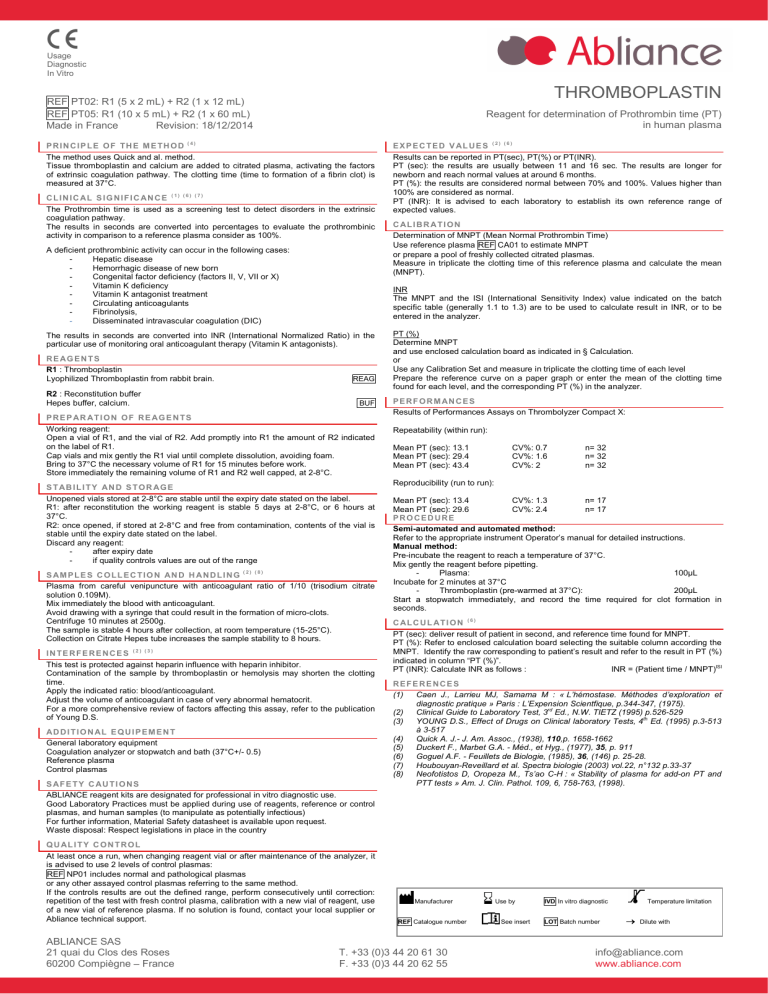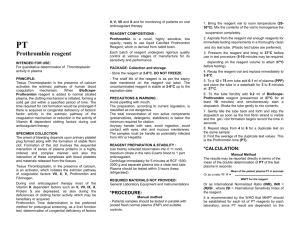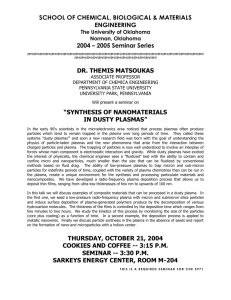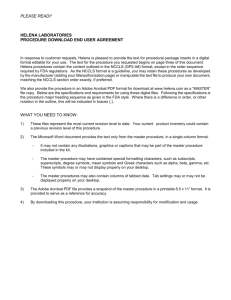thromboplastin

|
Usage
Diagnostic
In Vitro
REF PT02: R1 (5 x 2 mL) + R2 (1 x 12 mL)
REF PT05: R1 (10 x 5 mL) + R2 (1 x 60 mL)
Made in France Revision: 18/12/2014
P R I N C I P L E O F T H E M E T H O D
( 4 )
The method uses Quick and al. method.
Tissue thromboplastin and calcium are added to citrated plasma, activating the factors of extrinsic coagulation pathway. The clotting time (time to formation of a fibrin clot) is measured at 37°C.
C L I N I C A L S I G N I F I C A N C E
( 1 ) ( 6 ) ( 7 )
The Prothrombin time is used as a screening test to detect disorders in the extrinsic coagulation pathway.
The results in seconds are converted into percentages to evaluate the prothrombinic activity in comparison to a reference plasma consider as 100%.
A deficient prothrombinic activity can occur in the following cases:
- Hepatic disease
-
-
Hemorrhagic disease of new born
Congenital factor deficiency (factors II, V, VII or X)
-
-
-
-
-
Vitamin K deficiency
Vitamin K antagonist treatment
Circulating anticoagulants
Fibrinolysis,
Disseminated intravascular coagulation (DIC)
The results in seconds are converted into INR (International Normalized Ratio) in the particular use of monitoring oral anticoagulant therapy (Vitamin K antagonists).
R E A G E N T S
R1 : Thromboplastin
Lyophilized Thromboplastin from rabbit brain.
R2 : Reconstitution buffer
Hepes buffer, calcium.
REAG
BUF
P R E P A R A T I O N O F R E A G E N T S
Working reagent:
Open a vial of R1, and the vial of R2. Add promptly into R1 the amount of R2 indicated on the label of R1.
Cap vials and mix gently the R1 vial until complete dissolution, avoiding foam.
Bring to 37°C the necessary volume of R1 for 15 minutes before work.
Store immediately the remaining volume of R1 and R2 well capped, at 2-8°C.
S T A B I L I T Y A N D S T O R A G E
Unopened vials stored at 2-8°C are stable until the expiry date stated on the label.
R1: after reconstitution the working reagent is stable 5 days at 2-8°C, or 6 hours at
37°C.
R2: once opened, if stored at 2-8°C and free from contamination, contents of the vial is stable until the expiry date stated on the label.
Discard any reagent:
-
- after expiry date if quality controls values are out of the range
S A M P L E S C O L L E C T I O N A N D H A N D L I N G ( 2 ) ( 8 )
Plasma from careful venipuncture with anticoagulant ratio of 1/10 (trisodium citrate solution 0.109M).
Mix immediately the blood with anticoagulant.
Avoid drawing with a syringe that could result in the formation of micro-clots.
Centrifuge 10 minutes at 2500g.
The sample is stable 4 hours after collection, at room temperature (15-25°C).
Collection on Citrate Hepes tube increases the sample stability to 8 hours.
I N T E R F E R E N C E S ( 2 ) ( 3 )
This test is protected against heparin influence with heparin inhibitor.
Contamination of the sample by thromboplastin or hemolysis may shorten the clotting time.
Apply the indicated ratio: blood/anticoagulant.
Adjust the volume of anticoagulant in case of very abnormal hematocrit.
For a more comprehensive review of factors affecting this assay, refer to the publication of Young D.S.
A D D I T I O N A L E Q U I P E M E N T
General laboratory equipment
Coagulation analyzer or stopwatch and bath (37°C+/- 0.5)
Reference plasma
Control plasmas
S A F E T Y C A U T I O N S
ABLIANCE reagent kits are designated for professional in vitro diagnostic use.
Good Laboratory Practices must be applied during use of reagents, reference or control plasmas, and human samples (to manipulate as potentially infectious)
For further information, Material Safety datasheet is available upon request.
Waste disposal: Respect legislations in place in the country
Q U A L I T Y C O N T R O L
At least once a run, when changing reagent vial or after maintenance of the analyzer, it is advised to use 2 levels of control plasmas:
REF NP01 includes normal and pathological plasmas or any other assayed control plasmas referring to the same method.
If the controls results are out the defined range, perform consecutively until correction: repetition of the test with fresh control plasma, calibration with a new vial of reagent, use of a new vial of reference plasma. If no solution is found, contact your local supplier or
Abliance technical support.
ABLIANCE SAS
21 quai du Clos des Roses
60200 Compiègne – France
Manufacturer
REF Catalogue number
T. +33 (0)3 44 20 61 30
F. +33 (0)3 44 20 62 55
Reagent for determination of Prothrombin time (PT) in human plasma
E X P E C T E D V A L U E S
( 2 ) ( 6 )
Results can be reported in PT(sec), PT(%) or PT(INR).
PT (sec): the results are usually between 11 and 16 sec. The results are longer for newborn and reach normal values at around 6 months.
PT (%): the results are considered normal between 70% and 100%. Values higher than
100% are considered as normal.
PT (INR): It is advised to each laboratory to establish its own reference range of expected values.
C A L I B R A T I O N
Determination of MNPT (Mean Normal Prothrombin Time)
Use reference plasma REF CA01 to estimate MNPT or prepare a pool of freshly collected citrated plasmas.
Measure in triplicate the clotting time of this reference plasma and calculate the mean
(MNPT).
INR
The MNPT and the ISI (International Sensitivity Index) value indicated on the batch specific table (generally 1.1 to 1.3) are to be used to calculate result in INR, or to be entered in the analyzer.
PT (%)
Determine MNPT and use enclosed calculation board as indicated in § Calculation. or
Use any Calibration Set and measure in triplicate the clotting time of each level
Prepare the reference curve on a paper graph or enter the mean of the clotting time found for each level, and the corresponding PT (%) in the analyzer.
P E R F O R M A N C E S
Results of Performances Assays on Thrombolyzer Compact X:
Repeatability (within run):
Mean PT (sec): 13.1 CV%: 0.7 n= 32
Mean PT (sec): 29.4
Mean PT (sec): 43.4
Reproducibility (run to run):
CV%: 1.6
CV%: 2 n= 32 n= 32
Mean PT (sec): 13.4
Mean PT (sec): 29.6
P R O C E D U R E
CV%: 1.3
CV%: 2.4 n= 17 n= 17
Semi-automated and automated method:
Refer to the appropriate instrument Operator’s manual for detailed instructions.
Manual method:
Pre-incubate the reagent to reach a temperature of 37°C.
Mix gently the reagent before pipetting.
- Plasma:
Incubate for 2 minutes at 37°C
- Thromboplastin (pre-warmed at 37°C):
100µL
200µL
Start a stopwatch immediately, and record the time required for clot formation in seconds.
C A L C U L A T I O N ( 6 )
PT (sec): deliver result of patient in second, and reference time found for MNPT.
PT (%): Refer to enclosed calculation board selecting the suitable column according the
MNPT. Identify the raw corresponding to patient’s result and refer to the result in PT (%) indicated in column “PT (%)”.
PT (INR): Calculate INR as follows : INR = (Patient time / MNPT)
ISI
R E F E R E N C E S
(1) Caen J., Larrieu MJ, Samama M : « L’hémostase. Méthodes d’exploration et diagnostic pratique » Paris : L’Expension Scientfique, p.344-347, (1975).
(2) Clinical Guide to Laboratory Test, 3 rd
Ed., N.W. TIETZ (1995) p.526-529
(3) YOUNG D.S., Effect of Drugs on Clinical laboratory Tests, 4 th Ed. (1995) p.3-513
à 3-517
(4) Quick A. J.- J. Am. Assoc., (1938), 110,p. 1658-1662
(5) Duckert F., Marbet G.A. - Méd., et Hyg., (1977), 35, p. 911
(6) Goguel A.F. - Feuillets de Biologie, (1985), 36, (146) p. 25-28.
(7) Houbouyan-Reveillard et al. Spectra biologie (2003) vol.22, n°132 p.33-37
(8) Neofotistos D, Oropeza M., Ts’ao C-H : « Stability of plasma for add-on PT and
PTT tests » Am. J. Clin. Pathol. 109, 6, 758-763, (1998).
Use by
See insert
THROMBOPLASTIN
IVD In vitro diagnostic
LOT Batch number
Temperature limitation
→
Dilute with
info@abliance.com






